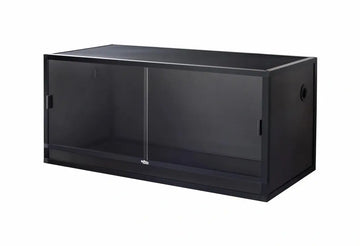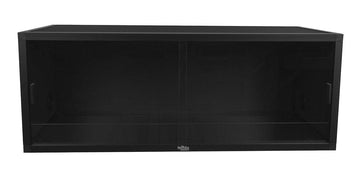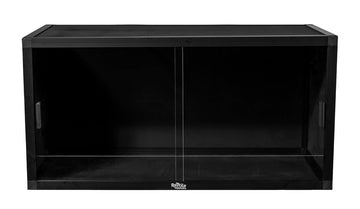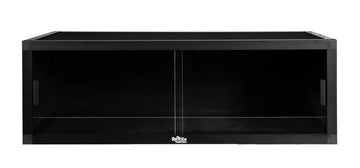Collared lizards (Crotaphytus spp.) are 8-12” long, diurnal, terrestrial lizards native to the southwestern US and northern Mexico. They prefer arid habitats such as desert scrub and dry grassland with rock terrain.
Collared lizards tend to have a fairly slim and athletic build, with a large, blunt head, a rounded midsection, fairly long legs, and a long, slender tail. Coloration tends to vary widely from species to species and even depending on sex, but most species have a spotted pattern and the telltale “collar” stripes near the neck.
Collared lizards are not common pets, and they are generally not very handleable, but they do make a good display species for someone looking for a small, active lizard.
There are 9 species of collared lizard:
-
Crotaphytus antiquus
-
Crotaphytus bicintores
-
Crotaphytus collaris
-
Crotaphytus dickersonae
-
Crotaphytus grismeri
-
Crotaphytus insularis
-
Crotaphytus nebrius
-
Crotaphytus reticulatus
-
Crotaphytus vestigium
Care requirements for different species of collared lizard will vary slightly, but they’re similar enough that the basics can be covered in a care sheet. We strongly encourage you, however, to do additional research specific to your collared lizard’s particular species.
Minimum terrarium size for collared lizards:
The absolute minimum enclosure size for a single collared lizard is 36” x 18” x 18”, or a 40 gallon breeder-style tank. However, collared lizards are very active, so if you can provide larger, your pet will absolutely use the extra space!
It is possible to successfully house multiple collared lizards together. For best results, do not house multiple males in the same enclosure, but one male and multiple females can work. However, cohabitation is optional. Your lizard will be just fine having the terrarium all to itself!
Do collared lizards need UVB?
Yes! Collared lizards require UVB lighting for their survival. UVB lighting helps provide a clear day/night cycle, provides all of the vitamin D that your pet needs, strengthens the immune system, facilitates better digestion, and other benefits.
The best UVB bulbs for a collared lizard housed in a 36-48” long enclosure is the:
Position the lamp on the same side of the terrarium as the heat lamp. If the UVB is mounted over mesh, place the basking surface 4-6” below the lamp. If the UVB is mounted inside the enclosure, place the basking surface 6-8” below the lamp.
They are also likely to benefit from plant grow lights as part of their environment as well. Add a ~6500K LED or T5 HO fluorescent grow lamp to provide extra illumination, as well as help any live plants in the enclosure to thrive. A fixture we recommend for this is the Arcadia Jungle Dawn.
Lights should be on for 10 hours/day during winter and 14 hours/day during summer to simulate seasonal changes in day length. All lamps should be turned off at night.
Best temperature for collared lizards:
Collared lizards need a basking surface temperature between 105-120°F, and 75-90°F on the cool side. Temperatures should be measured via infrared thermometer. For best results, use a flat piece of stone such as flagstone, paver stone, or unpolished stone tile as the basking surface.
Provide heat for your lizard with a halogen heat bulb placed above the basking branch. Halogen bulbs are the best way to imitate the warmth of sunlight indoors, and considered to be a superior form of reptile heating by experts. Do not use ceramic heat emitters (CHEs), red bulbs, or blue bulbs, as these are not as effective.
Best humidity levels for collared lizards:
Collared lizards need slightly different humidity depending on which species you’re dealing with. Collared lizards from the western part of their distribution do well between 30-40% humidity, while eastern collared lizard species are more likely to prefer humidity between 50-60%.
However, humidity isn’t something to worry about too much with this species. As long as you have a humid hideout or burrow available, they should be fine. Keep track of humidity levels with a digital probe hygrometer placed in the middle of the terrarium, and mist occasionally with a spray bottle.
Best substrate for collared lizards:
Substrate (aka bedding) covers the floor of the terrarium and helps make the enclosure more attractive, but it also helps maintain healthy joints and provides something for your lizard to dig in (which they love to do!)
We recommend the following substrates for collared lizards:
- Zoo Med ReptiSand
- Exo Terra Desert Sand
- Play sand
Substrate should be at least 4” deep and completely replaced every 3-4 months. Remove poop and urates daily, along with contaminated substrate.
How to decorate a collared lizard terrarium:
An empty enclosure makes for a bored collared lizard, reducing its quality of life. Keep your pet entertained and engaged with its environment with the strategic use of décor items that encourage it to exercise natural behaviors!
Since collared lizards are a terrestrial species that prefers rocky terrain, at bare minimum you will need a flat basking stone and a couple of places for them to hide. However, it’s best to include other items, such as:
- secure stacks of flagstone or aquarium slate
- more hiding places
- ledges
- hollow logs
- cork
- branches
- live or artificial plants
- dry shrubs
What to feed to a collared lizard:
Collared lizards are insectivores, which means that they need to eat primarily insects to get the right nutrition for their bodies. Live insects should be offered every morning, as many as your lizard will eat in one day. Juveniles generally eat a higher quantity of insects than adults.
Variety is the key to a balanced diet, so make sure to offer as many different types of insects as possible.
Feeder insects for collared lizards: dubia roaches, discoid roaches, red runner roaches, crickets, black soldier fly larvae, hornworms, and mealworms.
Supplements
You will also need calcium and vitamin supplements to help keep your collared lizard healthy. We recommend Repashy Calcium Plus LoD, lightly dusted on all insects. It’s okay to occasionally skip a dusting.
Water
Of course, don’t forget a small water bowl for your lizard to drink from! Change the water daily and scrub the bowl with a reptile-safe disinfectant weekly, or whenever it becomes soiled.
How to handle your collared lizard:
Reptiles generally don’t appreciate petting and handling in the same way that dogs and cats do. Some collared lizards learn to tolerate it, but they’re not a pet that you can hold often, as it’s likely to just stress them out. If you want to bond with your collared lizard, try hand-feeding it with feeding tweezers.
*This care sheet contains only very basic information. Although it’s a good introduction, please further your research with high-quality sources. The more you know, the better you will be able to care for your pet!











